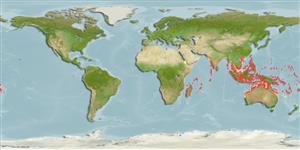Teleostei >
Anguilliformes (Eels and morays)
鰻目 (Eels and morays) >
Anguillidae (Freshwater eels)
鰻鱺科(Freshwater eels) (Freshwater eels)
Etymology: Anguilla: Latin, anguilla, .-ae = eel (Ref. 45335).
More on author: McClelland.
Environment: milieu / climate zone / depth range / distribution range
生态学
海洋; 淡水; 半咸淡水 居于水底的; 降海洄游 (Ref. 51243). 熱帶; 22°N - 27°S
Indo-Pacific: widespread in the tropical Indian Ocean and western Pacific. Known in Australia only from streams in the Kimberley regions of northern western Australia. Africa: widespread but relatively uncommon along east and southeast African coast and Madagascar (Ref. 7248, 52193). Mozambique; Lower Zambezi River (Ref. 39494). Most easily confused with Anguilla obscura and the surest way to distinguish them is by the count of vertebrae (Ref. 9828).
印度-太平洋: 在熱帶的印度洋與西太平洋中廣泛分佈。 在澳洲在澳洲西北部的慶伯利區域中只從溪流。 非洲: 廣泛分佈但是相當稀有的沿著東方與非洲海岸東南部與馬達加斯加.(參考文獻 7248) 莫三比克; 尚比西河下游河.(參考文獻 39494) 最容易與 安圭拉 obscura 與最可靠的方法互相混淆區別他們是藉著脊椎骨的數量.(參考文獻 9828)
大小 / 重量 / 年龄
Maturity: Lm ? range ? - ? cm
Max length : 123 cm TL 雄鱼/尚未辨别雌雄; (Ref. 6371); common length : 65.0 cm TL 雄鱼/尚未辨别雌雄; (Ref. 2871); 最大年龄: 20 年 (Ref. 48660)
背棘 (总数) : 0; 背的软条 (总数) : 240 - 245; 臀棘: 0; 臀鳍软条: 200 - 220; 脊椎骨: 105 - 115.
背部橄榄色到深蓝褐色, 腹部颜色较淡从颌到肛门.(参考文献 3971) 在排泄孔上面的背鳍起点.(参考文献 12693) 齿小的,不明显的, 多序列, 形成在颚与犁骨上的宽的连续条纹; 向后延伸到上颌的箍的犁骨齿箍但是更朝向后面.(参考文献 4832)
Migratory species which breeds in the ocean (Ref. 52331, 79840). Lives in fresh water areas as an adult, in estuaries and seas as young (Ref. 12693). Descends to the sea to spawn. Inhabits freshwater streams and pools, preferring marshy habitats (Ref. 41236). Found in rivers and creeks, commonly over rock bottoms and in deeper pools. Seldom occurs in large rivers (Ref. 6028). Restricted to lowland (coastal) reaches of river systems (Ref. 7248). Feeds on small fishes, crustaceans and mollusks. Reported to breed east of Madagascar; the south equatorial current probably carries the eel larvae and elvers towards the east coast of Africa where local coastal currents guide the elvers to suitable rivers which they invade and they stay there until sexually mature, when they return to their breeding grounds (Ref. 13337). Caught with various types of nets. Sometimes used in the aquarium trade (Ref. 6028).
在海洋中繁殖的回游种.(参考文献 52331) 生活在淡水区域当成鱼时, 在河口与海洋中当幼鱼时.(参考文献 12693) 下降到海洋产卵。 栖息于淡水溪流与水池, 偏爱多沼地的栖息地。 (参考文献 41236) 发现于河与小溪了, 通常在石质底部之上与在较深的水池中。 很少出现于大河中。 (参考文献 6028) 局限于低地 (海岸的) 河流域的范围了。 (参考文献 7248) 吃小鱼,甲壳动物与软件动物。 报告繁殖马达加斯加东方; 赤道南方的洋流可能运送鳗鱼仔鱼与鳗苗到非洲东岸在那里近岸洋流引導對適當的河他們侵入那一個的鰻苗,而且他們在那裡停留直到性成熟, 當他們回到他們的繁殖場的時候.(參考文獻 13337) 用各種不同類型的網捕獲了。 有時被用於水族貿易。 (參考文獻 6028)
Life cycle and mating behavior
Maturities | 繁殖 | Spawnings | Egg(s) | Fecundities | 仔鱼
印度-太平洋: 在熱帶的印度洋與西太平洋中廣泛分佈。 在澳洲在澳洲西北部的慶伯利區域中只從溪流。 非洲: 廣泛分佈但是相當稀有的沿著東方與非洲海岸東南部與馬達加斯加.(參考文獻 7248) 莫三比克; 尚比西河下游河.(參考文獻 39494) 最容易與 安圭拉 obscura 與最可靠的方法互相混淆區別他們是藉著脊椎骨的數量.(參考文獻 9828)
Kottelat, M., 2013. The fishes of the inland waters of Southeast Asia: a catalogue and core bibliography of the fishes known to occur in freshwaters, mangroves and estuaries. The Raffles Bulletin of Zoology 2013 (Suppl. 27):1-663. (Ref. 94476)
世界自然保护联盟红皮书 (Ref. 130435)
临近濒危 (NT) (A2bcde); Date assessed: 11 August 2019
人类利用
渔业: 低经济
工具
特别资料
下载 XML
网络资源
Estimates based on models
Preferred temperature (Ref.
123201): 26.5 - 29.1, mean 28.3 °C (based on 1098 cells).
Phylogenetic diversity index (Ref.
82804): PD
50 = 0.5000 [Uniqueness, from 0.5 = low to 2.0 = high].
Bayesian length-weight: a=0.00076 (0.00037 - 0.00155), b=3.17 (3.00 - 3.34), in cm total length, based on LWR estimates for this Genus-body shape (Ref.
93245).
营养阶层 (Ref.
69278): 3.6 ±0.50 se; based on food items.
回复力 (Ref.
120179): 低的, 最小族群倍增时间4.5 - 14 年 (tmax=20).
Fishing Vulnerability (Ref.
59153): High to very high vulnerability (74 of 100).
Nutrients (Ref.
124155): Calcium = 58.7 [34.4, 111.3] mg/100g; Iron = 0.801 [0.472, 1.318] mg/100g; Protein = 18.8 [17.0, 20.8] %; Omega3 = 0.29 [0.14, 0.60] g/100g; Selenium = 150 [74, 289] μg/100g; VitaminA = 13.3 [3.1, 51.7] μg/100g; Zinc = 0.925 [0.650, 1.373] mg/100g (wet weight); based on
nutrient studies.
